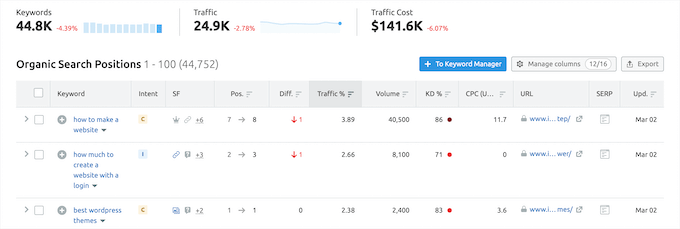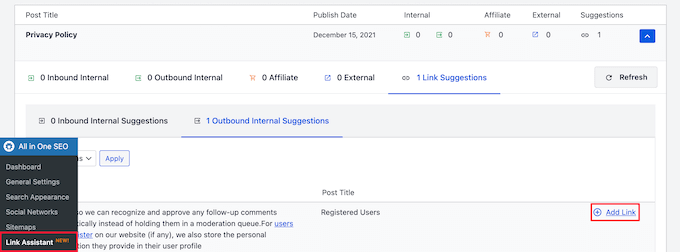
Would you like to know how you can optimize your blog posts for SEO? If YES, then you’re certainly in the right post.
Optimizing blog posts for SEO is important if you want to improve Google SERPs ranking and get as much as possible traffic to your website.
We are going to cover our best SEO tips in this article to help you optimize your blog posts like a pro. The tips below are what we use on our own blog, which receives millions of visitors every year from search engines.
Table of Contents
Getting more search engine traffic to your WordPress website by optimizing your blog posts for SEO is beneficial to your business.
Search engines are often the single largest source of website traffic, so having a strong search engine presence can be extremely valuable to a blog, online store, or small business website.
If you aren’t optimizing your WordPress SEO, you aren’t getting the necessary traffic and making the right amount of money.
In that regard, we’ve developed a checklist for optimizing your blog posts for SEO like a pro.
Many new bloggers use their best guess to determine what topics are likely to be popular with their readers.
There is no need to rely on guesswork, especially when you can conduct keyword research to determine what your users want.
Content creators and SEO specialists use keywords to determine what their users want. Based on your search engine data, you can discover topics that your users are interested in.
By using these keywords, you can then design a content strategy to meet their interests. If you do this, you will write about topics that people are interested in, which is an excellent way to build an engaged audience.
Semrush is an excellent tool for researching keywords. Besides providing valuable keyword data, they also provide competition analyses, keyword position tracking, and numerous other features.

Semrush’s SEO Writing Assistant is something you would want to check out if you are using the tool. The tool will help you learn more about LSIs and related keywords, language tone, and average article length.
The next step is to find a keyword that is easy to search for with the lowest competition and a high search volume.
That is your focus keyword. Users most likely use this phrase to find your content in a search engine.

The focus keyword can be set in your article’s SEO settings by using any of the popular SEO plugins. Using any of these plugins, you can see where you used it most effectively.
Your next step is to identify Latent Semantic Indexing (LSI). LSI refers to searches that resemble the key phrase that you are focusing on.
It’s easy to find them by simply entering your focus keyword in Google Search and scrolling down to the bottom of your results.

In order to provide your readers with the most complete content, you should incorporate as many of these keywords as possible.
Be careful not to overuse them in your content. User interfaces are going to look a little strange here, and search engines can detect keyword stuffing pretty well.
A blog post’s title has a significant impact on search engine rankings.
The better your article’s title, the more relevant it is to the search query. This is especially important because it inspires readers to click on your article when they find it in the search results.
Use your focus keyword in the title of your blog post to make it more SEO-friendly.

Along with your focus keyword, you’ll also want to make your headline interesting and clickable. CTR plays a vital role in SEO, so your organic click-through rate (CTR) plays a role as well.

Using a headline analyzer tool is the best way to accomplish this. Use this tool to rate your headline and learn how to improve it to make it more click-worthy and engaging.
Your readers will be more engaged and interested in your blog posts if you include images and videos. Search engine results will also rank better with content that readers enjoy.
Consider including fun images, image galleries, instructional images, etc.
Make sure you are aware of image copyrights when adding images. Beginners frequently copy images from other websites to utilize, which might land you in legal problems if done without necessary rights.
Don’t worry, there are several sites where you may obtain royalty-free images to use in your blog posts.
You may also use your own pictures or make your own using web design software such as Adobe Photoshop or Canva.
Images are less intriguing than videos. You may turn your blog entries into videos by making slideshows, vlogs, and other formats.
However, you should never add movies directly to your blog postings. WordPress is not designed to deliver videos, and your WordPress hosting service is incapable of doing so.
Instead, post your films to a video hosting service such as YouTube or Vimeo. These sites are designed to host your movies and can even serve as a secondary traffic source.
After a period of blogging, you will have enough articles that you want readers to read. You may direct potential new readers to earlier related content by using internal linking.

Internal linking is an excellent technique to establish a contexual relationship between new and old blog posts. It also enables you to direct relevant link juice to older content.

WordPress makes it simple to find past posts directly inside the post editor. Simply pick the text to be linked and click the link button.
The meta description is just a type of HTML meta tag that may be added to any page. Its objective is to give search engines and other crawlers a brief summary of your article.
According to several SEO experts, the meta tags tag has become obsolete. Many others, though, would disagree. We recommend utilizing the meta description for all of your posts at ThemeLooks.
A decent meta description may provide a lot more information about an article. When your content is shared on social networking networks such as Facebook, Twitter, and LinkedIn, it is also shown.
You may also include Facebook Open Graph Meta Data to modify your post’s description when it’s posted on Facebook.

You would like to make absolutely sure your meta descriptions are useful now that you know people will read them.
For search reasons, you should also include your focus keyword at least once in the meta description. The meta description character limit is 155 characters.
If you exceed that restriction, your meta description will be chopped off after 155 characters. You should also include your main keyword early in the meta description rather than afterward.
Readability is a must to get ranked higher in search engines. With having good readability score any blog post could rank higher than posts that don’t have an easy reading experience.
Unfortunately, both computer and mobile screens are not 100% optimal platforms yet.
This is why most people only skim articles. According to statistics, people spend less than a second deciding whether to stay on a page or depart.
You have only a few seconds to persuade the user to stay and scroll. You may make it easier for your users to skim an article by boosting its readability.
You have only a few seconds to persuade the user to stay and scroll. You may make it easier for your users to skim an article by boosting its readability.

Use shorter phrases, shorter sentences, punctuation, headers, and numbered lists to increase readability. To make your writing easier to understand, we recommend adding white space around it and incorporating graphics.
Categories and tags assist you in categorizing your blog content not just for yourself, but also for visitors and google searches.
The difficulty is that so many WordPress newcomers use them wrongly.
Consider your site to be a book, with categories serving as the table of contents and tags serving as the index.
Categories are used to organize the content on your WordPress site into important subjects. Tags, on the other hand, are the themes covered in a single blog article.
Articles that go into considerable detail about a topic are favored by search engines. This is why, as part of your content preparation process, we requested you to collect semantically relevant keywords (LSI Keywords).
These related keywords offer you an overview of the various permutations of user searches for that specific topic. You may make your content more complete, helpful, and valuable by including certain keywords.
You should incorporate such keywords in headers and subheadings and try to cover as much area as possible.
Aside from LSI keywords, another technique for creating full content is to enter your target keyword into Google and then select the ‘Image‘ option. There will be subject bubbles with various keywords.

We recommend adding these while developing your content to ensure that it is as comprehensive as possible.
Many newbies forget about their blog posts once they have published them. In reality, after your blog article is published, you haven’t finished optimizing it for SEO.
Following the publication of your blog article, you must perform the following:
Distribute it to your readers – Readers and subscribers will appreciate your fresh and old content. See our tutorial on how you can share your blog posts with readers.
Add internal links — After you’ve published a piece, go back to relevant older articles and provide a link to your new blog post. This offers your fresh content link juice while also making it easier for users to find.
Analyze search engine rankings – You’ve optimized an article for SEO, but how do you maintain track of where it ranks in search results?
We propose that you optimize previous content on a regular basis in order to maintain your rankings.
Google attempts to help individuals seeking answers as quickly as possible. They have developed the featured result or answer box as part of this endeavor.
This is the featured search result at the top of the page. Google provides a personalized snippet from the article’s text, emphasizing the section that their algorithms feel is the solution to the user’s inquiry.

According to the Advanced Web Ranking study, answer boxes have a CTR of around 32.3 percent. As a result, they are crucial to your SEO strategy.
Google does not give precise advice on how to obtain the highlighted snippet. Their advice is to update your content and ensure that it provides the information that users are looking for.
We hope this article helped you learn how to optimize your blog posts for SEO like a pro. You may also want to see our guide on how to fix the missing appearance menu in WordPress, and our expert picks of the best responsive WordPress themes you can count on in 2022.
If you like this post, be with ThemeLooks and subscribe to our WordPress video tutorials on YouTube. We may also be found on Twitter, LinkedIn, and Facebook.